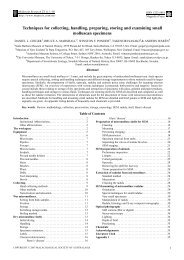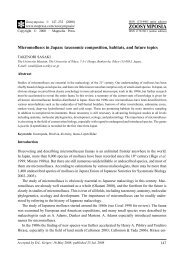Molluscs from Hydrothermal Vents and Cold Seeps in Japan: A ...
Molluscs from Hydrothermal Vents and Cold Seeps in Japan: A ...
Molluscs from Hydrothermal Vents and Cold Seeps in Japan: A ...
You also want an ePaper? Increase the reach of your titles
YUMPU automatically turns print PDFs into web optimized ePapers that Google loves.
124T. Sasaki, T. Okutani & K. FujikuraClade Heterobranchia Burmeister, 1837Family Pyramidellidae Gray, 1840Genus Eulimella Jeffreys, 184774. Eulimella sp.Eulimella sp.: Okutani & Fujiwara, 2000: 126, fig. 11.Distribution record: North Knoll of Iheya Ridge, Ok<strong>in</strong>awa Trough, 1049 m (Sh<strong>in</strong>kai 2000Dive 863) (Okutani & Fujiwara, 2000).Type of habitat: Vent.DiscussionAs listed above, a total of 74 molluscan species have been recorded <strong>from</strong> <strong>Japan</strong>ese vent/seepsites (Table 1). Among these, gastropods (42 species: 57% of total) <strong>and</strong> bivalves (30 species:41%) constitute a majority. In contrast, the rema<strong>in</strong><strong>in</strong>g classes are extremely scarce or totallyabsent.Caudofoveata <strong>and</strong> Solenogastres: No ‘aplacophorans’ have been collected <strong>from</strong> <strong>Japan</strong>esevent/seep localities so far. However, it is uncerta<strong>in</strong> whether they are actually absent. Their absencemay be an artifact of limited sampl<strong>in</strong>g methods.Polyplacophora: Two species <strong>in</strong> different families were described as new taxa <strong>from</strong> theOk<strong>in</strong>awa Trough (Leptochiton tenuidontus <strong>and</strong> Thermochiton undocostatus: Saito & Okutani,1990). They are extremely scarce <strong>and</strong> have not been reported aga<strong>in</strong>. They represent the onlyrecord of chitons <strong>from</strong> chemosynthetic communities <strong>in</strong> the world to date.Monoplacophora: No species of monoplacophorans (Neopil<strong>in</strong>idae <strong>and</strong> Micropil<strong>in</strong>idae) havebeen collected <strong>from</strong> <strong>Japan</strong>ese waters, although much attention has been paid to limpet-shapedmolluscs. Even the exam<strong>in</strong>ation of small limpets (less than 2 mm) could not reveal the presenceof monoplacophorans (Sasaki et al., 2003). The liv<strong>in</strong>g Monoplacophora are widely distributedma<strong>in</strong>ly <strong>in</strong> the Eastern Pacific, Antarctic sea, Northeast Atlantic <strong>and</strong> mid- to southwestern Pacificbetween 174 <strong>and</strong> 6489 m deep (Warén & Ha<strong>in</strong>, 1992: fig. 1; Haszprunar & Schaefer, 1997: table1). The only record of Monoplacophora <strong>in</strong> vents/seeps is represented by Rokopella segonzaciWarén & Bouchet, 2001, which was described <strong>from</strong> a hydrothermal vent <strong>in</strong> the Mid-AtlanticRidge (Warén & Bouchet, 2001: 118). F<strong>in</strong>d<strong>in</strong>g liv<strong>in</strong>g monoplacophorans is still major unrealizedgoal <strong>in</strong> <strong>Japan</strong>ese malacology.Bivalvia: Among 28 species of recorded bivalves, the diversity is especially high <strong>in</strong>Calyptogena (13 species) <strong>and</strong> Bathymodiolus (6 species) (Table 1). By contrast, other genera areconspicuously restricted.1) Protobranchia: It is one of notable characteristics that taxodont protobranchs are extremelyscarce <strong>in</strong> deep-sea vents <strong>and</strong> seeps, although they are often predom<strong>in</strong>ant on muddy bottoms atbathyal to abyssal depths (Knudsen, 1970, 1979; Zardus, 2002: 36-41).Cryptodont protobranchs (Solemyidae) are generally known to have symbiotic sulfideoxydiz<strong>in</strong>gbacteria <strong>in</strong>side their ctenidia. Their digestive system is reduced or even absent <strong>in</strong> somespecies, possibly depend<strong>in</strong>g on the <strong>in</strong>tensity of bacterial symbiosis (Reid, 1980, 1990). However,the ecology <strong>and</strong> anatomy of deep-sea solemyids has been little <strong>in</strong>vestigated. It is especiallyunclear whether an exceptionally large-sized species, Acharax johnsoni, is always associated withseeps or not. In contrast, Solemya tagiri is endemic to vents <strong>in</strong> Kagoshima Bay.2) Pteriomorphia: This group is represented exclusively by the mytilid genus Bathymodiolus,which is typical of vents <strong>and</strong> seeps <strong>in</strong> the Southwest Pacific, Northwest Pacific, Indian Ocean




